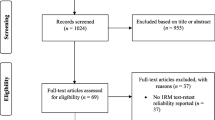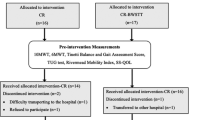Abstract
Background and aims: The Timed up and Go Test (TUG) is recommended as a screening tool for fall risk in older people. It is assumed that this general mobility test is underpinned by physiological factors such as strength, coordination and balance. However, no studies have examined the range of physiological and psychological factors which influence performance on this test. The aim of this study was to examine the relative contributions of a range of sensorimotor, balance and psychological factors to TUG performance in a large sample of older people. Methods: 280 community-dwelling people aged 65 plus years (mean age 74.9, SD=6.4) underwent the TUG test, as well as quantitative tests of vision, peripheral sensation, strength, reaction time, balance, fear of falling, pain and vitality. Results: The time required to complete the TUG was significantly related to limitations in instrumental activities of daily living and fear of falling. Many physiological and psychological factors were significantly associated with TUG performance in univariate analyses. Stepwise multiple regression analyses identified knee strength, postural sway, reaction time, edge contrast sensitivity, MMSE score, SF12 body pain and general health scores, number of medical conditions and age as significant and independent predictors of TUG performance. Of these measures, the lower limb strength measure explained most variance in TUG times. However, other sensorimotor, balance, psychological and health measures provided important independent information. The combined set of variables explained 43.5% of the variance in TUG times (multiple r=0.65). Conclusions: Findings indicate that, in community-dwelling older people, TUG performance is influenced by lower limb strength, balance, reaction time, vision and pain, in addition to cognitive function and health status.
Similar content being viewed by others
References
AGS/BGS Clinical Practice Guideline: Prevention of Falls in Older Persons; Available at: http://www.americangeriatrics.org/education/prevention_of_falls.shtm. Accessed 12 Jan 2010
Mathias S, Nayak U, Issacs B. Balance in elderly patients: The “get-up and go” test. Arch Phys Med Rehabil 1986; 67: 387–9.
Podsiadlo D, Richardson S. The timed “up and go” a test of basic functional mobility for frail elderly persons. J Am Geriatr Soc 1991; 39: 142–8.
Kim MJ, Seino S, Kim MK et al. Validation of lower extremity performance tests for determining the mobility limitation levels in community-dwelling older women. Aging Clin Exp Res 2009; 21: 437–44.
de Vreede PL, Samson MM, van Meeteren NL, Duursma SA, Verhaar HJ. Reliability and validity of the Assessment of Daily Activity Performance (ADAP) in community-dwelling older women. Aging Clin Exp Res 2006; 18: 325–33.
Rockwood K, Awalt E, Carver D. Feasibility and measurement properties of the functional reach and the timed up and go tests in the Canadian study of health and aging. J Gerontol A Biol Sci Med Sci 2000; 55: M70–3.
Shumway-Cook A, Brauer S, Woollacott M. Predicting the probability for falls in community-dwelling older adults using the Timed Up & Go test. Phys Ther 2000; 80: 896–903.
Thompson M, Medley A. Performance of community dwelling elderly on the Timed Up and Go test. Phys Occup Ther Geriatr 1995; 13: 17–30.
Russell MA, Hill KD, Blackberry I, Day LM, Dharmage SC. The reliability and predictive accuracy of the falls risk for older people in the community assessment (FROP-Com) tool. Age Ageing 2008; 37: 634–9.
Thomas J, Lane J. A pilot study to explore the predictive validity of 4 measures of falls risk in frail elderly patients. Arch Phys Med Rehabil 2005; 86: 1636–40.
Thrane G, Joakimsen R, Thornquist E. The association between timed up and go test and history of falls: the Tromso study. BMC Geriatrics 2007; 7: 1.
Boulgarides LK, McGinty SM, Willett JA, Barnes CW. Use of clinical and impairment-based tests to predict falls by communitydwelling older adults. Phys Ther 2003; 83: 328–39.
Stel VS, Smit JH, Pluijm SM, Lips P. Balance and mobility performance as treatable risk factors for recurrent falling in older persons. J Clin Epidemiol 2003; 56: 659–68.
Trueblood P, Hodson-Chennault N, McCubbin A. Performance and impairment-based assessments among community dwelling elderly: sensitivity and specificity. Issues Aging 2001; 24: 2–6.
Daubney M, Culham E. Lower-extremity muscle force and balance performance in adults aged 65 years and older. Phys Ther 1999; 79: 1177–85.
Manckoundia P, Buatois S, Gueguen R et al. Clinical determinants of failure in balance tests in elderly subjects. Arch Gerontol Geriatr 2008; 47: 217–28.
Crum R, Anthony J, Bassett S, Folstein M. Population-based norms for the Mini-Mental State Examination by age and educational level. JAMA 1993; 269: 2386–91.
Folstein M, Folstein S, McHugh P. Mini-mental state. A practical method for grading the cognitive state of patients for the clinician. J Psychiatr Res 1975; 12: 189–98.
Lawton M, Brody E. Assessment of older people: self-maintaining and instrumental activities of daily living. Gerontologist 1969; 9: 179–86.
Lord SR, Menz HB, Tiedemann A. A physiological profile approach to falls risk assessment and prevention. Phys Ther 2003; 83: 237–52.
Lord SR, Ward JA, Williams P. Exercise effect on dynamic stability in older women: a randomized controlled trial. Arch Phys Med Rehabil 1996; 77: 232–6.
Gandek B, Ware J, Aaronson N. Cross-validation of item selection and scoring for the SF-12 Health Survey in nine countries: results from the IQOLA Project. International Quality of Life Assessment. J Clin Epidemiol 1998; 51: 1171–8.
Yesavage JA, Brink TL, Rose TL et al. Development and validation of a geriatric depression screening scale: a preliminary report. J Psychiatr Res 1982–1983; 17: 37–49.
Yardley L, Beyer N, Hauer K. Development and initial validation of the Falls Efficacy Scale-International (FES-I). Age Ageing 2005; 34: 614–9.
SPSS for Windows. Release 17. SPSS Inc, Chicago, Il, 2008.
Wennie Huang WN, Perera S, Vanswearingen J, Studenski S. Performance measures predict onset of Activity of Daily Living difficulty in community-dwelling older adults. J Am Geriatr Soc 2010; 58: 844–52.
Delbaere K, Close JC, Mikolaizak A, Sachdev P, Brodaty H, Lord SR. The Falls Efficacy Scale International (FES-I). A comprehensive longitudinal validation study. Age Ageing 2010; 39: 210–6.
Austin N, Devine A, Dick I, Prince R, Bruce D. Fear of falling in older women: a longitudinal study of incidence, persistence, and predictors. J Am Geriatr Soc 2007; 55: 1598–603.
Binda SM, Culham EG, Brouwer B. Balance, muscle strength, and fear of falling in older adults. Exp Aging Res 2003; 29: 205–19.
Aslan UB, Cavlak U, Yagci N, Akdag B. Balance performance, aging and falling: a comparative study based on a Turkish sample. Arch Gerontol Geriatr 2008; 46: 283–92.
Buchner DM, Larson EB, Wagner EH, Koepsell TD, de Lateur BJ. Evidence for a non-linear relationship between leg strength and gait speed. Age Ageing 1996; 25: 386–91.
Tiedemann A, Sherrington C, Lord SR. Physiological and psychological predictors of walking speed in older community dwelling people. Gerontology 2005; 51: 390–5.
Lord SR, Murray S, Chapman K, Munro B, Tiedemann A. Sit-tostand performance depends on sensation, speed, balance, and psychological status in addition to strength in older people. J Gerontol A Biol Sci Med Sci 2002; 57: M539–43.
Salem G, Wang M, Young J, Marion M, Greendale G. Knee strength and lower- and higher-intensity functional performance in older adults. Med Sci Sports Exerc 2000; 32: 1679–84.
Schenkman M, Hughes MA, Samsa G, Studenski S. The relative importance of strength and balance in chair rise by functionally impaired older individuals. J Am Geriatr Soc 1996; 44: 1441–6.
Skelton DA, Greig CA, Davies JM, Young A. Strength, power and related functional ability of healthy people aged 65–89 years. Age Ageing 1994; 23: 371–7.
Bean J, Kiely D, Herman S. The relationship between leg power and physical performance in mobility-limited older people. J Am Geriatr Soc 2002; 50: 461–7.
Tiedemann A, Sherrington C, Lord SR. Physical and psychological factors associated with stair negotiation performance in older people. J Gerontol A Biol Sci Med Sci 2007; 62: 1259–65.
Lord SR, Fitzpatrick RC. Choice stepping reaction time: a composite measure of falls risk in older people. J Gerontol A Biol Sci Med Sci 2001; 56: M627–32.
Imms FJ, Edholm OG. Studies of gait and mobility in the elderly. Age Ageing 1981; 10: 147–56.
Lee DN, Lishman JR. Visual proprioceptive control of stance. J Hum Mov Stud 1975; 1: 87–95.
Simoneau GG, Cavanagh PR, Ulbrecht JS, Leibowitz HW, Tyrrell RA. The influence of visual factors on fall-related kinematic variables during stair descent by older women. J Gerontol 1991; 46: M188–95.
Lord SR, Dayhew J. Visual risk factors for falls in older people. J Am Geriatr Soc 2001; 49: 508–15.
Lord SR, Menz HB. Visual contributions to postural stability in older adults. Gerontology 2000; 46: 306–10.
Boyle PA, Wilson RS, Buchman AS et al. Lower extremity motor function and disability in mild cognitive impairment. Exp Aging Res 2007; 33: 355–71.
Centre of Disease Control and Prevention (CDC). Racial / ethnic disparities in prevalence, treatment, and control of hypertension — United States, 1999–2002. MMWR Morb Mortal Wkly Rep 2005; 54: 7–9.
McBean AM, Li S, Gibertson DT, Collins AJ. Differences in diabetes prevalence, incidence, and mortality among the elderly of four racial/ethnic groups: whites, blacks, Hispanics, and Asians. Diabetes Care 2004; 27: 2317–24.
Author information
Authors and Affiliations
Corresponding author
Rights and permissions
About this article
Cite this article
Kwan, M.MS., Lin, SI., Chen, CH. et al. Sensorimotor function, balance abilities and pain influence Timed Up and Go performance in older community-living people. Aging Clin Exp Res 23, 196–201 (2011). https://doi.org/10.1007/BF03324960
Received:
Accepted:
Published:
Issue Date:
DOI: https://doi.org/10.1007/BF03324960




